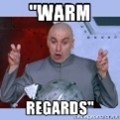Are you looking for a way to sign off a letter to someone you know? You could wish them “warm regards.” This post unpacks the meaning and origin of this expression.
Meaning
The expression “warm regards” means that you wish someone well and give them your best. It’s a greeting appearing in informal conversations between friends who know each other or people with some history together.
Saying warm regards as a farewell greeting is the same as others like “good luck” or “take care.” You can use it in written and verbal communications as a way to sign off and leave. You can use “warm regards” and “Warmest regards” interchangeably, as they have the same meaning.
If you say “warm regards” to someone, you tell them that you hope they stay safe and well until you see them again.
Example Usage
“Please send Clive my warmest regards when you see him. I haven’t kept in touch with him nearly as much as I should, and it’s been ages since we last spoke.”
“I wish you and your family warm regards for the holidays. I hope you have a fun, festive season and bring in the new year with a bang.”
“We’ll see you next year in the summer. Thanks for everything and warm regards to the neighbors when you see them; it was great meeting all these new people this year.”
“Send warm regards to the Cooper’s for me, would you, honey? I’m not going to make the dinner; I’m caught up here at work until late tonight.”
“Please send your folk's warm regards for me. I’m sorry they can’t come through to us this Christmas due to the travel restrictions.”
“Remember to pass warm regards to the Colonel when you see him. Tell him that I’ve been meaning to call, but life gets in the way. He’ll understand.”
“I’m sorry I can’t make it to the dinner party tonight, we have to see Kim’s father, he just got back from the hospital. Please send everyone my warm regards.”
“It’s a chilly winter this year, and I’m sending you warm regards for the holidays. Stack the fire high and stay toasty with a mug of hot cocoa.”
“Well, give Shirley my warmest regards. I’ll be in touch with her soon.”


Origin
The expression “warm regards” originates from the 1800s and the advent of professional letter writing. There is no official record of the first time the greeting appears in print, and language experts are unsure of its first use in English. The phrase remains a popular term in modern letter writing and email communications.
Phrases Similar to Warm Regards
- Kind regards.
- Best regards.
Phrases Opposite to Warm Regards
- Duly noted.
What is the Correct Saying?
- Warm regards.
- Warmest regards.
Ways People May Say Warm Regards Incorrectly
Some people may confuse the use of “warm regards” with other variations like “best regards” and “kind regards.” However, these two variations are better suited for more formal business or professional writing situations.
“Best regards” and “kind regards” are more suited to situations where you only know the person through an initial introduction, or you don’t know the person, and you’re writing to introduce yourself.
Acceptable Ways to Phrase Warm Regards
You can use “warm regards” in social and professional communications. It’s a common signing-off greeting in formal and informal writing and common in corporate communications. When you’re saying “warm regards” to someone, you have usually met them before, or it is someone that you work closely with at a professional level. It’s also suitable for signing emails to clients that you deal with regularly.
You can use the saying in verbal communications. You would use it when leaving the premises of someone you don’t know too well, as a way to show them that you wish them the best. Or you could use it when signing off from a phone conversation, such as “Send Bill my warmest regards please, I’ll see you soon.”